There are about 8.7 million species, that we know of anyway, on planet Earth. With so many animals, it’s likely you haven’t kept track of each and every one. We all know about lions, tigers, and bears (oh my!), but when you really dig deeper, you might be surprised by the strange animals roaming around out there in the wild. From weird looking amphibians to pokey mammals, the sheer amount of diversity in the animal kingdom is pretty amazing! Curious to see what oddball beasts we found? Here are 25 Bizarre Animals You Didn’t Know Exist.

Narwhal
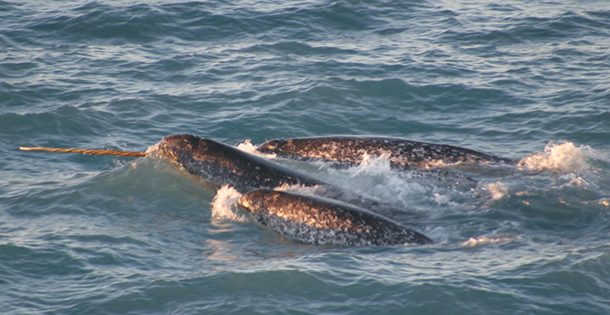 Source: https://www.nationalgeographic.com/animals/mammals/n/narwhal/
Source: https://www.nationalgeographic.com/animals/mammals/n/narwhal/ Okay, maybe some of you know narwhals exist. One did make an appearance in the holiday movie favorite Elf. But perhaps for others of you, the idea of a narwhal existing is totally new. Narwhals are unicorns of the sea. Porpoises with gigantic tusks that look like a giant sword. Crazy enough, no one really knows what it’s for.
Gerenuk
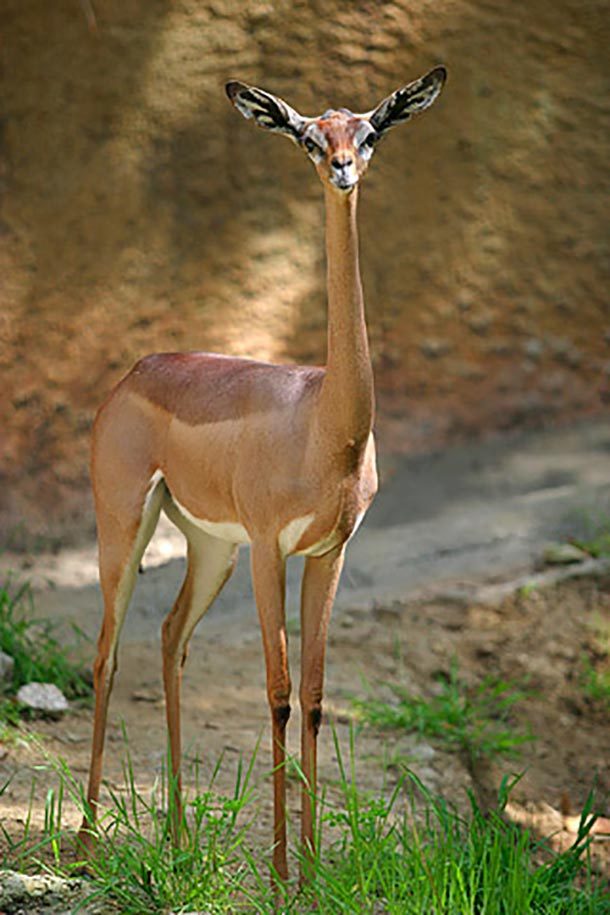 Source: https://www.britannica.com/animal/gerenuk
Source: https://www.britannica.com/animal/gerenuk The first thing most notice about the gerenuk is its incredibly long neck. It has the longest neck in the gazelle family. A rather shy animal, it’s not very sociable and will usually run away or stand perfectly still if detected.
Giant Isopod
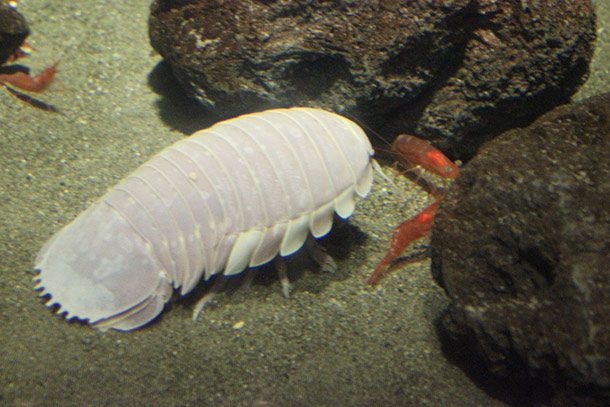 Source: http://www.seasky.org/deep-sea/giant-isopod.html
Source: http://www.seasky.org/deep-sea/giant-isopod.html If you’re wondering if aliens are out there, you might want to look to the seas. The Giant Isopod is so bizarre and alien-like, it’ll probably give you the creeps. A bottom feeder, it crawls around on the ocean floor, seeking food. It becomes so big because of “deep sea gigantism,” a phenomenon where deep-sea creatures grow much larger than similar creatures in the shallow water.
The Pacu Fish
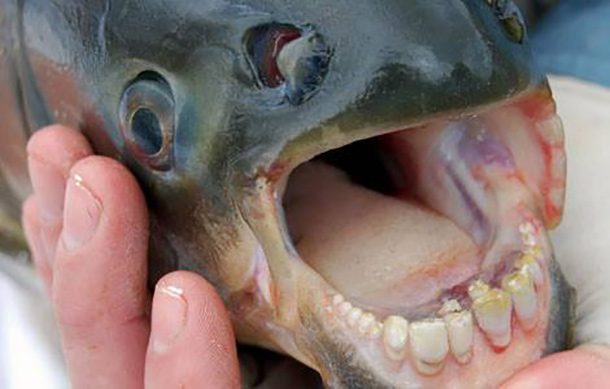 Source: https://news.nationalgeographic.com/2015/06/150624-pacu-fish-new-jersey-lake-testicle-eating-myth/
Source: https://news.nationalgeographic.com/2015/06/150624-pacu-fish-new-jersey-lake-testicle-eating-myth/ The Pacu Fish, a relative of the piranhas, have human-like teeth, and they’re much closer to home than you think. These fish are an invasive species and were recently found in New Jersey. A myth spread around that they liked to bite human male testicles, but of course, that’s a sack of lies.
The Panda Ant
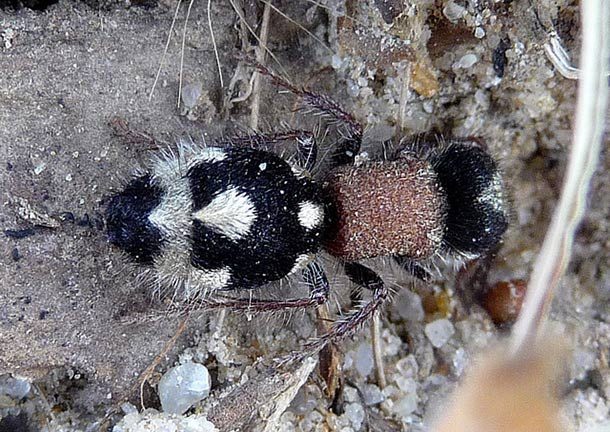 Source: https://www.boredpanda.com/panda-ant-cow-killer-euspinolia-militaris/
Source: https://www.boredpanda.com/panda-ant-cow-killer-euspinolia-militaris/ Speaking of lies, the Panda Ant is neither a panda nor an ant, but a wasp with a very painful sting. It’s been called the “Cow-Killer Ant” as well. Solitary by nature, they can be found in Chile and Argentina.
Mantis Shrimp
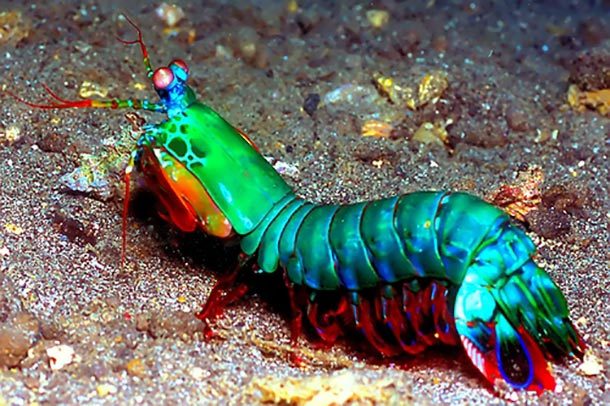 Source: https://aqua.org/explore/animals/mantis-shrimp
Source: https://aqua.org/explore/animals/mantis-shrimp Not only is the mantis shrimp a colorful creature, it also has some very interesting superpowers. It’s protruding eyes have 16 receptive cones which can detect ten times more color than a human, including ultraviolet light. On top of that, its eyes can move independently, allowing it to watch its back while it attacks its own prey.
Umbonia Spinosa
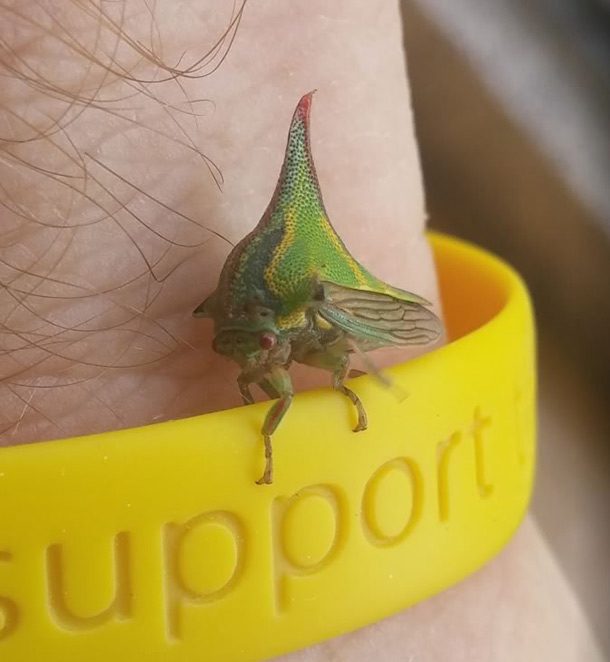 Source: http://entnemdept.ufl.edu/creatures/orn/thorn_bug.htm
Source: http://entnemdept.ufl.edu/creatures/orn/thorn_bug.htm This bizarre-looking leaf creature is known as Umbonia Spinosa or “Thorn Bug.” It hangs around fruit trees in Florida. By piercing the plant, it can suck the sap right up. In fact, some tree trunks in Florida were so heavily infested by these guys, they killed the tree entirely.
Red-lipped Batfish
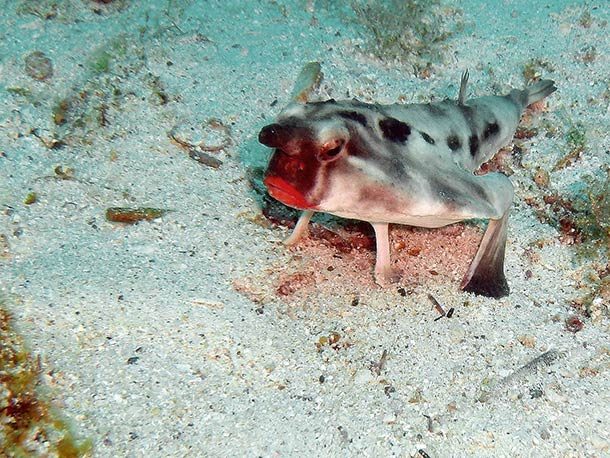 Source: https://www.theverge.com/2016/6/12/11884594/red-lipped-batfish-verge-animal-review
Source: https://www.theverge.com/2016/6/12/11884594/red-lipped-batfish-verge-animal-review Looking like it just put on a bright shade of red lipstick, the Red-lipped Batfish isn’t so much a fish but a crawling stingray. It’s a horrible swimmer and mostly crawls around on the bottom of the ocean, looking to devour its prey.
Glaucus Atlanticus
 Source: https://www.mnn.com/earth-matters/animals/blogs/3-fascinating-facts-about-blue-dragons-sea
Source: https://www.mnn.com/earth-matters/animals/blogs/3-fascinating-facts-about-blue-dragons-sea The Glaucus Atlanticus goes by many names, including blue angel, blue dragon, and blue sea slug. It uses clever camouflage to protect itself from predators above and below the sea. They’re also hermaphrodites. When two of them mate, they both produce egg strings.
Bombyx Mori
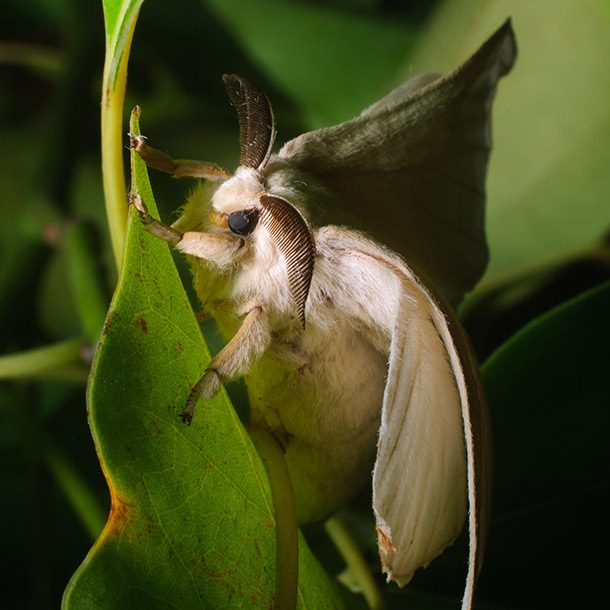 Source: http://www.wormspit.com/bombyxsilkworms.htm
Source: http://www.wormspit.com/bombyxsilkworms.htm The Bombyx Mori also called the China Silkworm, is a fuzzy looking moth that likes to hang out on blueberry trees. While they might look cuddly, they’re actually pretty disgusting as they like to mate with anything moth-sized and secrete a fluid off their bodies when they get excited.
Lowland Streaked Tenrec
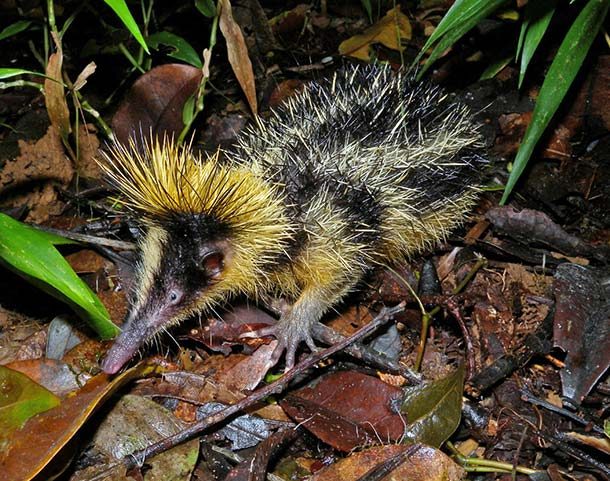 Source: http://bioweb.uwlax.edu/bio203/s2014/mcgrane_kyle/
Source: http://bioweb.uwlax.edu/bio203/s2014/mcgrane_kyle/ This porcupine look-a-like is actually a Lowland Streaked Tenrec and can only be found in Madagascar. They reside primarily on the east side of the island. If they get separated from a group of tenrec, they can use sound vibrations to communicate and tell the others where they are.
Saiga Antelope
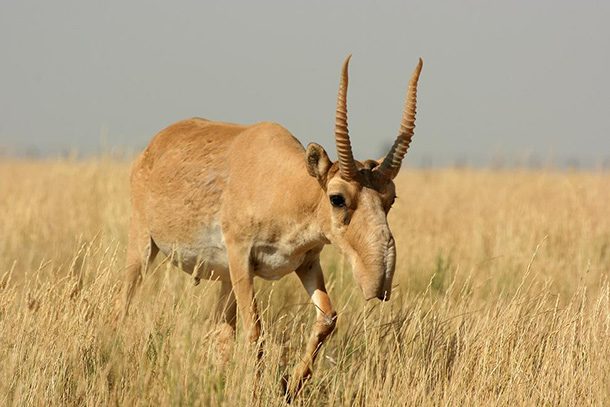 Source: http://wwf.panda.org/what_we_do/endangered_species/saiga_antelope/
Source: http://wwf.panda.org/what_we_do/endangered_species/saiga_antelope/ The saiga antelope can use its long nose to breathe in clean air on dusty days. It lives on the plains of Mongolia, but its population is critically endangered with only 50,000 remaining on Earth.
Bush Viper
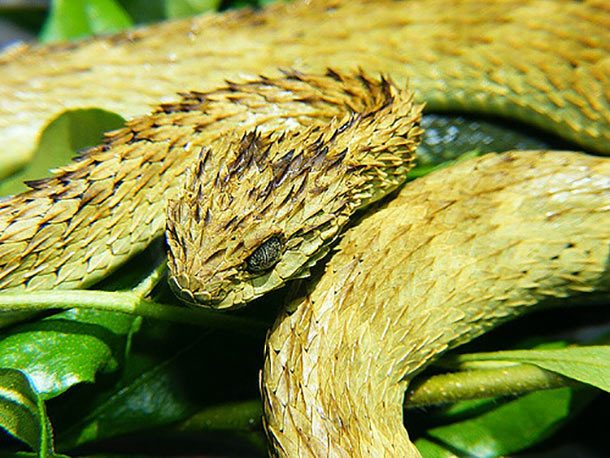 Source: http://www.reptilesmagazine.com/Snake-Species/Bush-Viper/
Source: http://www.reptilesmagazine.com/Snake-Species/Bush-Viper/ Found in Kenya and Tanzania, the bush viper is a rather scaly and sometimes colorful snake with a vicious bite. They aren’t very active, however, and are capable of hanging coiled on a tree without moving for days.
Goblin Shark
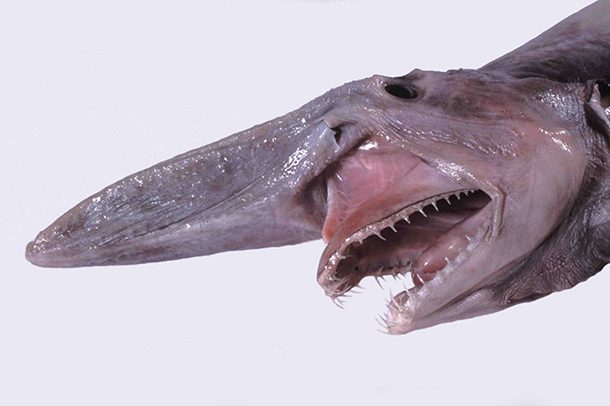 Source: https://kids.nationalgeographic.com/animals/goblin-shark/#goblin-shark-jaw.jpg
Source: https://kids.nationalgeographic.com/animals/goblin-shark/#goblin-shark-jaw.jpg Growing up to 12 feet (3.6 meters) long and weighing up to 460 pounds (208.6 kg), the goblin shark can be found swimming around the ocean floor near Japan. The most bizarre thing about them is their ability to extend their jaws outward to snap and catch their prey.
Indian Purple Frog
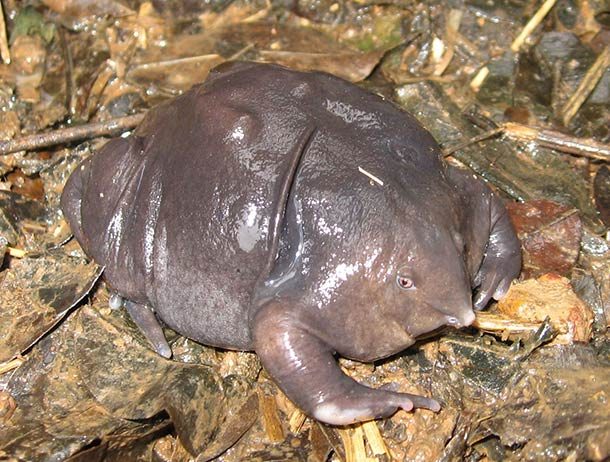 Source: https://news.nationalgeographic.com/2017/08/purple-frog-new-species-discovery-india-monsoon/
Source: https://news.nationalgeographic.com/2017/08/purple-frog-new-species-discovery-india-monsoon/ The Indian Purple Frog is not your average frog. It hardly even looks like one in the first place. It was first discovered in the Western Ghats mountain range in India. Apparently, its body is evolutionarily designed to allow it to spend most of its life below ground.
Okapi
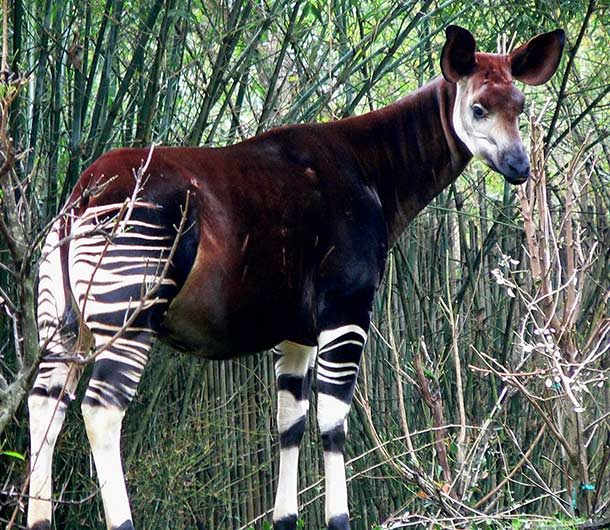 Source: http://animals.sandiegozoo.org/animals/okapi
Source: http://animals.sandiegozoo.org/animals/okapi While you might think the okapi is related to a zebra because of its stripes, you’d be wrong. It’s actually the only living relative of the giraffe. Much like their giraffe kin, they have very long tongues that can reach their eyes and ears.
Hummingbird Hawk-Moth
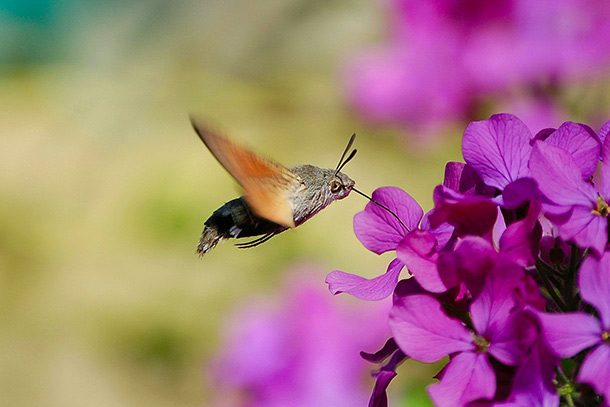 Source: http://www.pbs.org/wnet/nature/blog/featured-creature-hummingbird-hawk-moth/
Source: http://www.pbs.org/wnet/nature/blog/featured-creature-hummingbird-hawk-moth/ The Hummingbird Hawk-Moth is a weird combination of all the things in its namesake. It hovers over flowers collecting nectar like a hummingbird but has the appearance of a hawk. In reality, it’s a moth.
Sea Pig
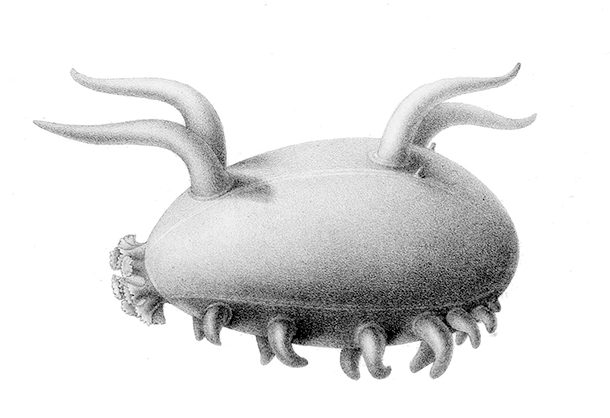 Source: https://www.wired.com/2014/06/the-creature-feature-10-fun-facts-about-sea-pigs/
Source: https://www.wired.com/2014/06/the-creature-feature-10-fun-facts-about-sea-pigs/ Sea pigs are, of course, not pigs at all but sea cucumbers, and it’s hard to deny they look pretty freaky. Even though they exist in all the world’s oceans, people will unlikely ever see one because of the cold and deep environments they choose to call home.
Atretochoana Eiselti
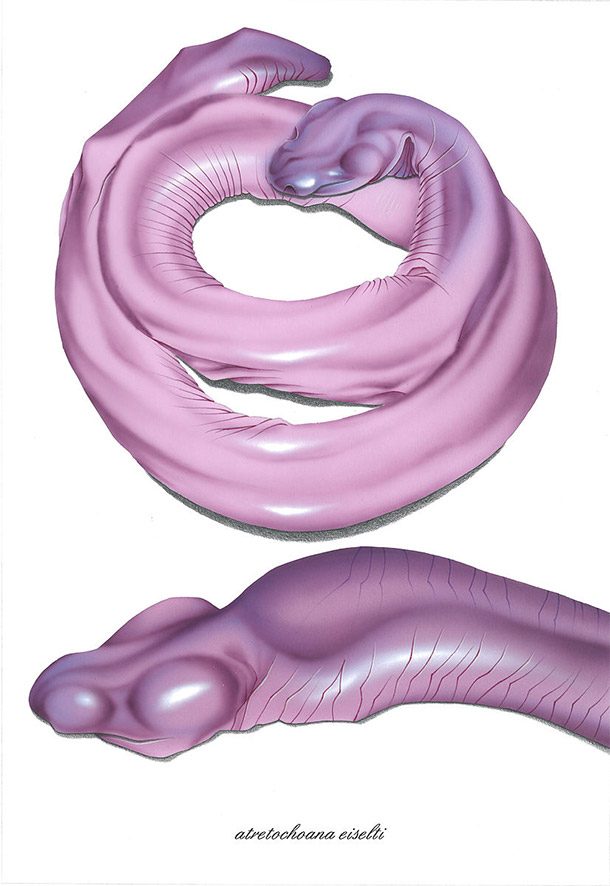 Source: https://news.mongabay.com/2012/08/penis-snake-discovered-in-brazil-is-actually-a-rare-species-of-amphibian/
Source: https://news.mongabay.com/2012/08/penis-snake-discovered-in-brazil-is-actually-a-rare-species-of-amphibian/ The Atretochoana Eiselti goes by another, less-scientific name. We’ll just let you guess what that is. It might look like a snake, but it’s actually not a reptile at all but an amphibian. It’s primarily aquatic, lacking lungs and breathing through its skin instead.
Jaguarundi
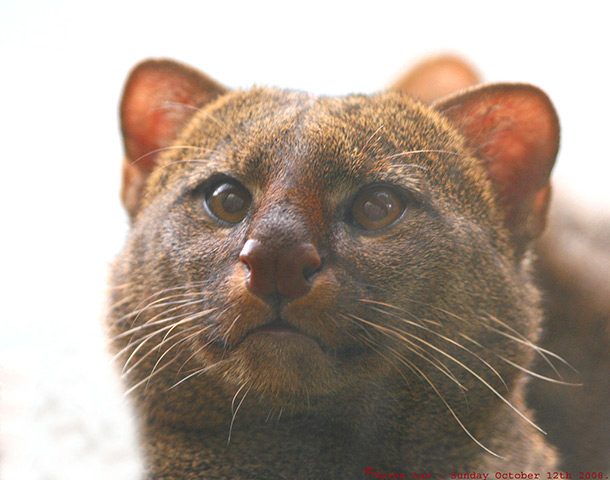 Source: http://www.arkive.org/jaguarundi/puma-yagouaroundi/
Source: http://www.arkive.org/jaguarundi/puma-yagouaroundi/ A strange South American cat is the Jaguarundi, a weasel-like cat with a slender body and flat head. Unlike the jaguar, it doesn’t have spots but does have a wide display of colors for its species. While its known for being in South America, they’ve been found in North and Central America as well.
Shoebill
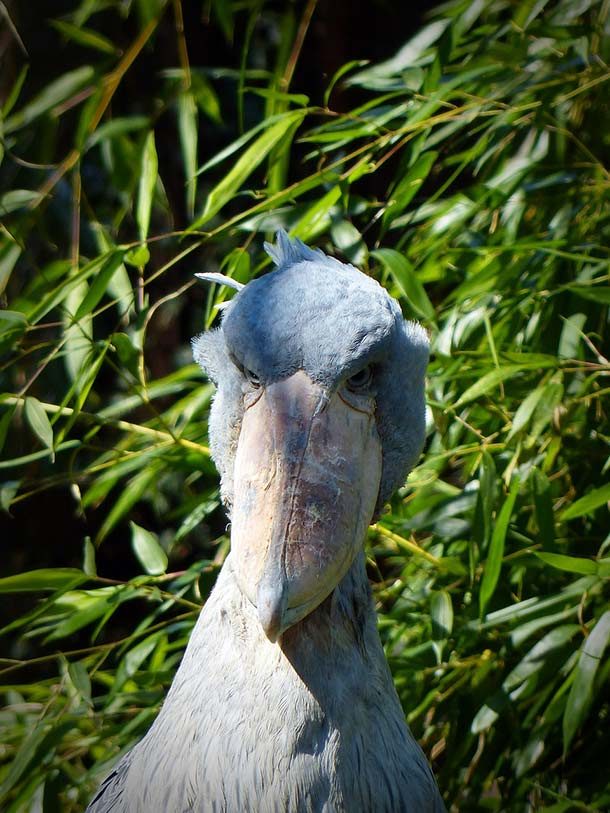 Source: http://www.bbc.co.uk/nature/life/Shoebill
Source: http://www.bbc.co.uk/nature/life/Shoebill Similar to a pelican or stork, the shoebill is remarkably more terrifying and murderous. Located in Africa, the shoebill waits like a statue in swamps for its prey. Once something comes along, it strikes like a terror in the night.
Thorny Dragon
 Source: https://www.wired.com/2014/09/the-creature-feature-10-fun-facts-about-the-thorny-devil/
Source: https://www.wired.com/2014/09/the-creature-feature-10-fun-facts-about-the-thorny-devil/ Covered in spikes all over its body like rose thorns, thorny dragons live up to their name and then some. It’s believed their spikes are to ward off predators. Living in Australia, they only eat ants and can change color depending on the temperature.
Blue Parrotfish
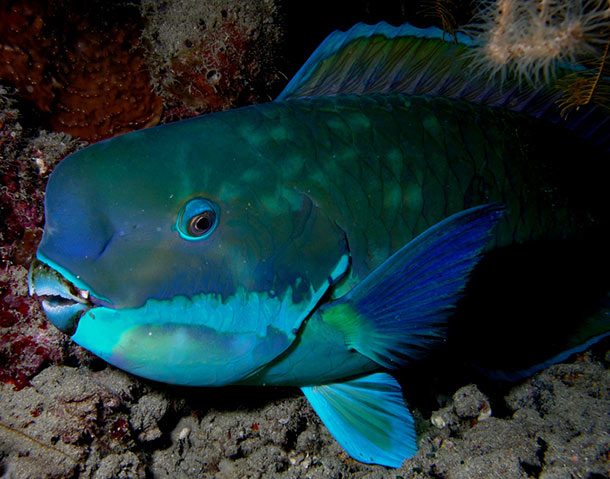 Source: http://marinebio.org/species.asp?id=601
Source: http://marinebio.org/species.asp?id=601 Blue Parrotfish are a bright blue with a yellow spot on their head. Most interestingly, however, is their beak-like jaws with fused teeth to eat algae from rocks. They also have pharyngeal teeth to grind rocks into sand.
Dumbo Octopus
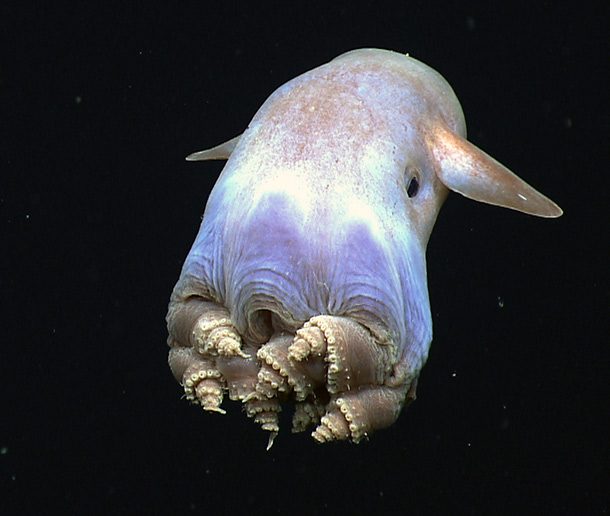 Source: http://ocean.si.edu/ocean-photos/grimpoteuthis-dumbo-octopus
Source: http://ocean.si.edu/ocean-photos/grimpoteuthis-dumbo-octopus Living at extreme depths of 13,000 feet (3962.4 meters), the dumbo octopus is a relatively small animal that hovers on the ocean floor, looking for snails or worms.
Pink Fairy Armadillo
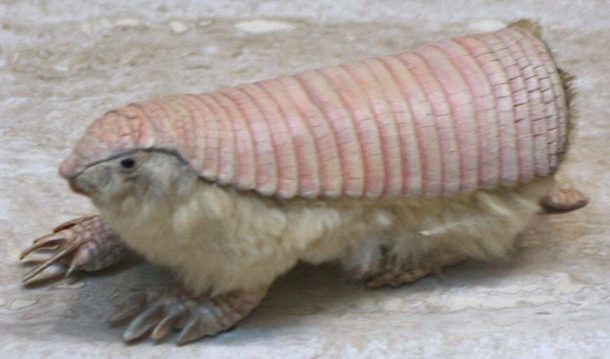 Source: https://www.wired.com/2014/01/absurd-creature-of-the-week-pink-fairy-armadillo-crawls-out-of-the-desert-and-into-our-hearts/
Source: https://www.wired.com/2014/01/absurd-creature-of-the-week-pink-fairy-armadillo-crawls-out-of-the-desert-and-into-our-hearts/ Looking like a cross between a pillbug and a guinea pig, the pink fairy armadillo has to be one of the most bizarre animals on the planet. You likely will never see one in the wild as they’re more comfortable digging through solid earth than walking on land. They’re so rare and hard to find that scientists aren’t even sure if they’re endangered or not.
Lists Going Viral Right Now
Photo: 25. NOAA (Public Domain), 24. By Aaron Logan, Lightmatter gerenuk, CC BY 1.0, 23. Laika ac from USA, Laika ac Deep sea creatures (7472073020), CC BY-SA 2.0, 22. Nisamanee wanmoon, ปลาเปคู (Pacu), CC BY-SA 4.0, 21. gailhampshire via flickr. CC BY 2.0, 20. charlene mcbride via flickr. CC BY 2.0, 19. Camilousuga, Umbonia spinosa (Bicho espino), CC BY-SA 4.0, 18. Rein Ketelaars, Red-lipped Bat fish, CC BY-SA 2.0, 17. Imtorn, Glaucus atlant., CC BY-SA 3.0, 16. Ash Bowie, Silkmoth, CC BY-SA 3.0, 15. Frank Vassen, Lowland Streaked Tenrec, Mantadia, Madagascar, CC BY 2.0, 14. Navinder Singh, Saiga tartarica, CC BY-SA 4.0, 13. Bree McGhee via flickr. CC BY 2.0, 12. Dianne Bray / Museum Victoria, Mistukurina owstoni museum victoria – head detail, CC BY 3.0 AU, 11. Karthickbala at ta.wikipedia, Nasikabatrachus sahyadrensis, CC BY-SA 3.0, 10. Raul654, Okapi2, CC BY-SA 3.0, 9. Ba’Gamnan at en.wikipedia, Hummingbird Hawk-moth, CC BY-SA 2.5, 8. Wikipedia Commons.com (Public Domain), 7. Tobias von Anhalt, Atretochoana eiselti, CC BY-SA 3.0, 6. Keven Law from Los Angeles, USA, Jaguarondi portrait, CC BY-SA 2.0, 5. Pixabay.com (Public Domain), 4. Bäras, Thornydevil, CC BY-SA 3.0, 3. Nhobgood, Parrotfish turquoisse, CC BY-SA 3.0, 2. Wikipedia Commons.com (Public Domain), 1. Original: cliff1066™, Pink Fairy Armadillo (Chlamyphorus truncatus) (cropped), CC BY 3.0



























